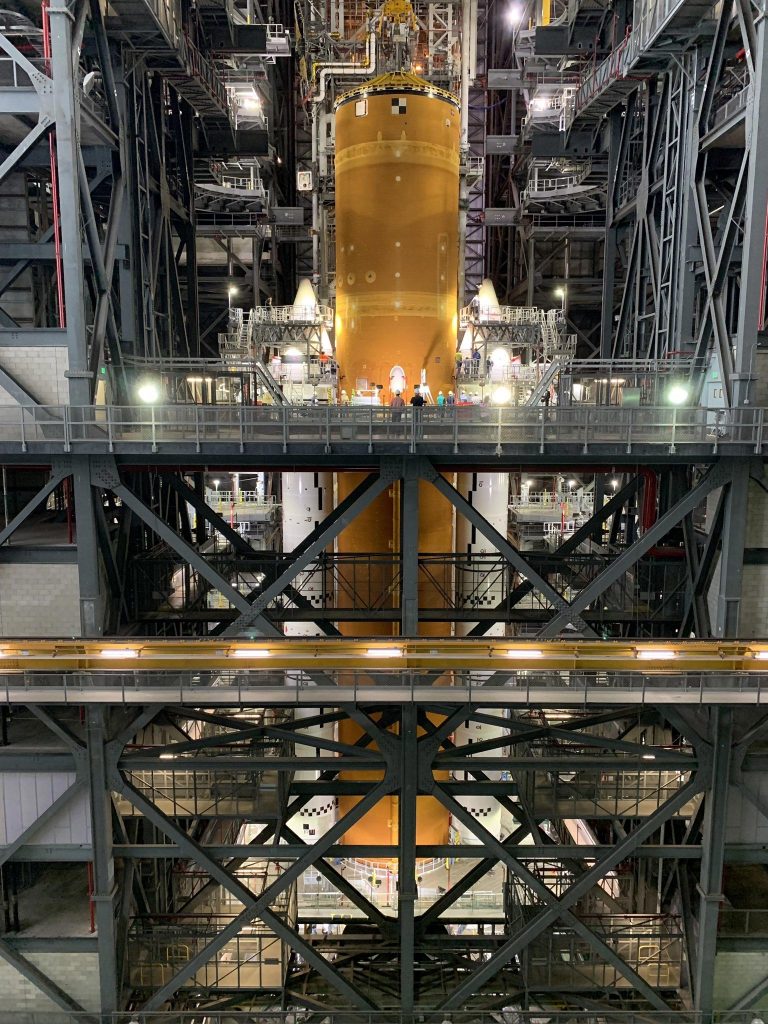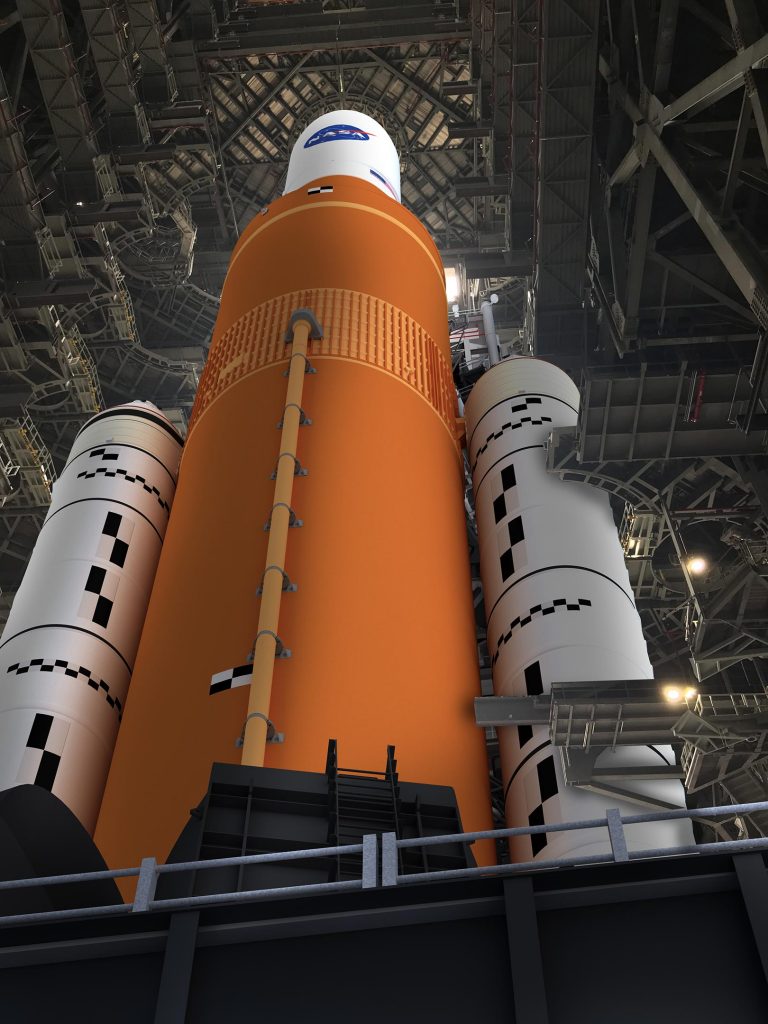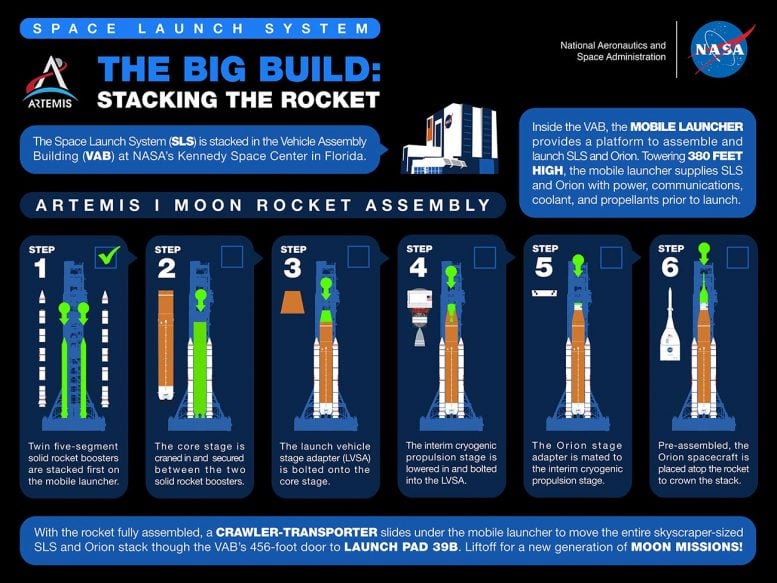
Space Launch System (SLS) rocket’s 188,000-pound core stage has been lifted onto the mobile launcher, in between the two solid rocket boosters. Credit: NASA
Making progress on our Artemis Moon rocket, images from a close encounter with a Jovian moon, and a ring of fire for our Moon … a few of the stories to tell you about – This Week at NASA!
Video Transcript:
Making progress on our Artemis Moon rocket. Images from a close encounter with a Jovian moon. And a ring of fire for our Moon. A few of the stories to tell you about This Week at NASA!
Stacking and assembly activities for the agency’s uncrewed Artemis I mission continue at our Kennedy Space Center.
These activities involve lifting the Space Launch System (SLS) rocket’s 188,000-pound core stage onto the mobile launcher, in between the two solid rocket boosters.

This illustration shows NASA’s Space Launch System (SLS) in its Block 1 configuration inside the Vehicle Assembly Building at NASA’s Kennedy Space Center in Florida. From top to bottom, the entire rocket measures about 312 feet high and has the capability of lifting payloads with a mass of more than 26 metric tons (57,000 pounds). Credit: NASA
That will be followed by the stacking and integration of other elements, and eventually the addition of the Orion spacecraft.
The twin solid rocket boosters and the core stage will provide more than 8.8 million pounds of thrust during the launch of NASA’s next-generation Artemis Moon missions.

Before it launches from NASA’s Kennedy Space Center in Florida, the agency’s Exploration Ground Systems (EGS) and Jacobs teams at the spaceport stack the different elements of the SLS rocket on top of the mobile launcher inside the iconic Vehicle Assembly Building. So large that it’s a Florida Space Coast landmark, the VAB as well as the mobile launcher have been specially outfitted to accommodate SLS and Orion. Once fully assembled, the upgraded crawler-transporter will carry the skyscraper-sized duo to the launch pad for NASA’s next-generation Moon missions. Credit: NASA
Our Juno mission sent back images after its June 7 flyby of Jupiter’s moon Ganymede, showing remarkable surface detail, including craters, distinct areas of dark and bright terrain, and features possibly linked to tectonic faults.
The flyby is expected to yield insights into the moon’s composition and makeup, including measurements of its radiation environment that could benefit future missions to the Jovian system.
Learn more about the mission at: nasa.gov/juno
On June 10, people across the northern hemisphere had a chance to experience an annular or a partial eclipse of the Sun.
Canada, Greenland, and northern Russia experienced an annular eclipse, during which the alignment of the Moon, Sun, and Earth are such that there appears to be a ring of fire around the Moon.
Elsewhere, including in parts of the eastern U.S. and northern Alaska, the Moon only blocked a smaller portion of the Sun.
Find out more about eclipses at nasa.gov/eclipse.
A SpaceX Dragon cargo spacecraft arrived at the International Space Station on June 5, two days after launching from our Kennedy Space Center.
The Dragon delivered more than 7,300 pounds of cargo, including the new ISS Roll-out Solar Arrays (iROSA) for the station, a science experiment with squids that could help with protective measures to keep astronauts healthy on long-duration space missions, a study on microscopic organisms called water bears, that might help humans deal with the stress factors of human spaceflight, and more.
This is SpaceX’s 22nd contracted commercial resupply mission to the station for NASA.
On June 9, NASA announced that two teams of scientists from the Wake Forest Institute for Regenerative Medicine in Winston-Salem, North Carolina, are the first and second place winners of the Vascular Tissue Challenge, a prize competition to grow and sustain functioning human tissue in a lab.
On Earth and in space, improved lab-grown vascularized tissue could be used for better disease modeling and could accelerate related research for organ transplants, as well as development of new therapeutics for long-term deep-space missions.
The NASA TechRise Student Challenge is a new STEM education-based competition that will kick-off for the 2021-22 school year for teams of sixth through 12th graders.
The contest aims to inspire a deeper understanding of Earth’s atmosphere, space exploration, coding, and electronics, as well as a broader understanding of the value of test data.
For more details check out nasa.gov/stem.
That’s what’s up this week @NASA. For more on these and other stories, follow us on the web at nasa.gov/twan.
Article From & Read More ( NASA: Progress on Giant SLS Moon Rocket, Close Encounter With Ganymede, and a Ring of Fire Eclipse - SciTechDaily )https://ift.tt/3gtYwwF
Science
No comments:
Post a Comment